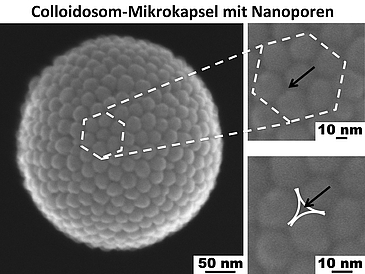They are 1,000-times smaller than a grain of sand and 20-times thinner than a human hair. This is the size of a novel class of microcapsules aptly called Submicron Colloidosomes. Colloidosomes have a great potential to be used in medical therapies. Materials scientist from the University of Bremen (Germany) and Stanford (USA) have now developed the next generation of nanoparticle based microcapsules with diameters in the range of 300 nanometers. In this respect it’s actually size that matters, being more than 10-times smaller than the smallest previously described colloidosomes. This now opens novel paths for the treatment of various diseases, like, for example, cancer.
These microcapsules can be compared to a tiny ball that is filled with water and whose shell is build from individual nanoparticles. This shell is the important part: Tiny holes between the particles are created featuring diameters of 1 to 5 nanometers. These pores can selectively control the administration of e.g. drugs that are encapsulated in the capsule. Tobias Bollhorst, who is working on the submicron colloidosomes for his dissertation at the Advanced Ceramics group at the University of Bremen, is certain that these capsules will eventually be used in the field of medicine: “It is our long-term goal to incorporate chemotherapeutics in the colloidosomes and then use the shell-forming particles for enhanced tumor treatment, like magnetic nanoparticles that are already used today for hyperthermia cancer treatment. By this we might be able to significantly increase the efficiency of certain cancer treatments.” The miniaturization of colloidosomes is the key breakthrough towards the application as drug carriers.
The Secret of the New Microcapules: Lipids
A recently published article in the journal "Chemistry of Materials” describes the synthesis process and the properties of the microcapsules in detail. The recipe for secret of the new colloidosomes is in the usage of so-called lipids (fatty acids) that stabilize the capsules. Fatty acids are nontoxic for the human organism. The fatty acids self-assemble between the capsule-forming particles and in so doing stabilize the colloidosomes.
Michael Maas, a former postdoctoral fellow at Stanford University and now senior scientist at the Advanced Ceramics group, laid the foundations for the synthesis of the new microcapsules two years ago. Together with co-author Gerd Fuller Maas conducted extensive research on the formation of extremely thin layers or films consisting of nanoparticles and fatty acids. This basic research was of major importance for today’s development of this innovative active substance carrier.
Professor Kurosch Rezwan, director of the advanced ceramics group at the University of Bremen sees great potential in the new microcapsules: “We achieved a real breakthrough by pushing colloidosomes below a diameter of 500 nanometer, though this is just the beginning. We are certain that these types of new microcapsules have great properties and will be used for many applications. Our primary goal is to optimize the system in the next years and bring the submicron colloidosomes from the lab to application.” Moreover Rezwan points out that the quality of the high resolution electron microscopy images would not have been possible without close collaboration with Prof. Rosenauer and Tim Grieb of the Institute of Solid State Physics at the University of Bremen.
Full citation of the scientific article: Tobias Bollhorst, Tim Grieb, Andreas Rosenauer, Gerald Fuller, Michael Maas, Kurosch Rezwan: Synthesis Route for the Self-Assembly of Submicrometer-Sized Colloidosomes with Tailorable Nanopores, Chemistry of Materials, 2013, in print
Abstract:
pubs.acs.org/doi/abs/10.1021/cm401610a
Further information:
University of Bremen
Faculty of Production Engineering
Advanced Ceramics
M.Sc. Tobias Bollhorst
Phone: +49 421 218 64961
email: bollhorstprotect me ?!uni-bremenprotect me ?!.de
Dr.rer. nat. Michael Maas
Phone: +49 421 218 64939
email: michael.maasprotect me ?!uni-bremenprotect me ?!.de
Prof.Dr.-Ing. Kurosch Rezwan
Phone: +49 421 218 64930
email: krezwanprotect me ?!uni-bremenprotect me ?!.de

